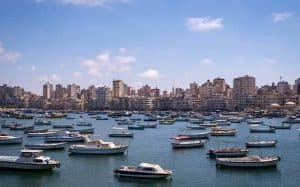The Andean Textiles: Weaving a Cultural Tapestry in South America’s Rich History

Updated On: April 17, 2024 by Eman Sameh
The Andean region of South America presents a spectacular array of cultural heritage through the medium of textiles. These are not just pieces of cloth but intricate tapestries of life that have been woven for centuries, preserving the history, beliefs, and values of the Andean peoples. The creation of Andean textiles involves various materials and fibres, each lending unique qualities to the finished product. From the high-altitude terrains where alpacas and llamas provide wool to the coastal areas rich in plant dyes, these resources are carefully transformed by skilled artisans using time-honoured techniques.

Throughout the Andes, textiles have played an influential role, serving not only as functional items for everyday use but also as significant markers of social status and political power. The weavings capture a visual language of iconography and symbolism, communicating stories and knowledge from generation to generation. From the intricate patterns found in Cumbi textiles to the societal significance of these creations during the Inka period, every thread spun and woven is a testament to the deeply rooted traditions of Andean cultures.
As modernity intertwines with ancient practices, the importance of preserving and exhibiting these textiles becomes ever more apparent, with museums across the world showcasing their beauty and complexity. Equally, the artistic expression found within these works provides an economic lifeline for many communities while encouraging the continuation of cultural practices and the introduction of innovations in Andean textile art.
History of Andean Textiles
The Andean region, cradled in the heart of South America, boasts a profound legacy of textile arts that stretches back over millennia. Our exploration zeroes in on the tapestry of historical narratives that these textiles embody, from pre-Columbian societies to the transformative Colonial Period.
Pre-Columbian Textile Art
The Inca Empire, often revered for its architectural feats, was also a cradle for intricate textile creation. Mastery of weaving and the symbolism of patterns were pivotal in Inca culture, as well as those of the Wari, Tiwanaku, and Chimú civilisations. In Central Peru, finds such as those from the Chancay people show a diverse range of textile art forms, using materials like cotton and alpaca wool. The technical sophistication seen in these textiles evolved notably around 1800 B.C., setting the stage for the complex societal structures that would characterise the region.
Textile Techniques
- Weaving: Incorporating intricate patterns with cultural significance
- Dyeing: Utilising natural pigments for vibrant, lasting colours
- Knotting: Creating detailed works and clothing from local materials
Materials Used
- Cotton: Primarily grown in coastal areas
- Camelid fibers: Sourced from alpacas and llamas
- Natural dyes: Derived from plants and insects, such as cochineal
The Impact of the Colonial Period
During the Colonial Period, Andean textiles underwent a transformation as European influences seeped into the region. Spanish colonialists introduced new materials and styles, integrating their own aesthetic preferences while also recognising the value of local expertise. This period saw a fusion of indigenous and foreign techniques, giving rise to a hybrid form of textile art unique to the Andes. Despite this, indigenous communities retained much of their traditional knowledge and continued interweaving their identity into each piece.
Changes in Textile Art
- Introduction of European fibres and dyes
- New forms of apparel influenced by colonial fashion
- Persistence of traditional patterns while incorporating new motifs
Our insight into the historical progression of Andean textiles reveals not just an artistic practice but a cultural language that has withstood the test of time. These textiles serve as a testament to the resilience and adaptability of Andean societies through the ages.
Materials and Fibres
The selection of materials in Andean textiles is as rich and varied as the culture itself. Our focus is on the natural fibres indigenous to the Andes and the art of dyeing that imparts vibrant life to their textiles.
Natural Fibres of the Andes
The Andean peoples have long mastered the art of textile creation using an array of natural fibres. Cotton stands out for its use in garments due to its breathability and availability. However, the true stars of Andean fibres are the camelids, mainly alpacas and llamas. These animals provide wool that is not only soft and warm but also highly durable.
- Alpaca: Prized for its fine fibres, it is softer and more luxurious than llama wool.
- Llama: Coarser than alpaca, these fibres are nonetheless versatile and resilient.
Feathers and shells were also integrated into textile works for ceremonial purposes, emphasising the sacred connection to nature.
Dyeing Techniques
The colours in Andean textiles are not merely for aesthetic pleasure; they hold deep cultural significance. Dyeing techniques have been refined over centuries to achieve a spectrum of hues, utilising natural dyes derived from plants, minerals, and even insects.
- Cochineal: A crimson dye sourced from insects, resulting in vibrant reds and pinks.
- Indigo: Extracted from plants to produce deep blues.
- Tara: A pod-producing tree that yields tannins used for brown and beige colours.
Through these materials and dyeing practices, Andean textiles become a woven tapestry of cultural expression.
Textile Production Techniques
In the rich tapestry of South American culture, Andean textiles emerge as a vibrant testament to artistic dexterity and innovation. The techniques employed in their creation are both ancient and intricate, involving a multitude of processes that contribute to their uniqueness.
Weaving Methods
Weaving in the Andes utilises an array of looms, including backstrap and horizontal ground looms. The technique of weaving varies, with notable methods such as warp-facing and weft-facing weaves. These are often combined to create complex patterns. Traditional Andean weaving is characterised by its tightness and durability, which stems from the high tension applied during the weaving process.
Knotting and Embroidery
Knotting is another cardinal technique in Andean textile production. The art of knotting includes the creation of textiles through intricate processes such as macramé, which is often utilised for decorative purposes. Embroidery adds depth and narrative to the textiles, with numerous methods developed to embellish fabrics. This combination of knotting and embroidery leads to elaborate designs that are rich with symbolism.
Advanced Pre-Columbian Techniques
The Andean textile tradition boasts advanced techniques that predate the arrival of Europeans. Brocade, a method that involves weaving raised patterns into textiles, was already being applied with sophistication. Dyeing, too, was a skillfully executed practice. Using natural dyes and pigments such as cochineal, weavers created vivid colours that have retained their brilliance over centuries.
The application of these techniques is not just a means of crafting textiles; it is the preservation and perpetuation of a culture that has woven its narrative through the threads of history.
Iconography and Symbolism

In the intricate world of Andean textiles, every thread and colour weaves together a narrative rich with iconography and symbolism. Through their motifs and symbols, these textiles chronicle stories of identity, religion, and the cosmos.
Motifs and Their Meanings
Our textiles often feature a variety of geometric designs and motifs, each with distinct meanings linked to our cultural identity and natural environment. Geometric patterns are commonly inspired by the rugged terrain and local flora and fauna of the Andes. We incorporate intricate patterns that can represent village life, agricultural cycles, and important clans or family ties.
Religious and Cultural Symbols
Symbols in our textiles are deeply embedded with religious and cultural significance. For instance, the Inti, representing the sun god, is a recurrent symbol expressing the reverence for the celestial deity pivotal in our cosmology. Such symbols are not mere artistic expressions but serve as mediums that bind the material world to the spiritual, reflecting our enduring cultural values and worldviews.
Through these symbols, Andean textiles preserve an ancient narrative, giving us insights into our ancestors’ connection with the earth and the divine. They encapsulate our history, stories, and beliefs, transcending mere aesthetic value.
Social and Political Significance

In the tapestry of Andean culture, textiles were far more than mere fabric; they were potent symbols of social and political structure.
Textiles as Status Symbols
Textiles in the Andean regions were not simply utilitarian objects; they were emblems of status. High-status individuals often wore elaborate and finely made clothing, like the tunics known as unkus. The complexity of the weave, the vibrancy of the colours, and the rarity of the materials all denoted an individual’s rank within the society. We see clothing serving as a visual language that signalled a person’s social standing and affiliations.
The Role of Textiles in the Inca State
The Inca state recognised the importance of textiles, utilising them not just as political tools but as quasi-currency and signifiers of political allegiance. Officials would distribute textiles to reward loyalty and service, reinforcing hierarchical social structures. These fabrics played a crucial role in state ceremonies and were pivotal in consolidating and displaying the power of the empire. Thus, the textile industry was meticulously controlled by the Inca, ensuring that the quality and distribution of textiles reflected and maintained the social order.
Andean Textiles in Modern Times
Our exploration of Andean textiles reveals a seamless blend of tradition and contemporary relevance. Today, these textiles continue to weave their cultural significance into the fabric of South American societies, particularly in Bolivia and Peru.
Contemporary Weaving Practices
We find that traditional weaving practices still thrive, as local artisans intricately weave garments that preserve the heritage of their ancestors. Using age-old techniques, weavers from Bolivia and Peru create patterns and designs that have been passed down through generations. Each piece mirrors the rich textile traditions of the Andes, with a vibrant display of colours and symbols that narrate the stories of their communities.
Textiles as a Sustainable Livelihood
Textiles are more than cultural artefacts; they remain a vital occupation in the Andean region. For many, the art of textile production is a sustainable livelihood that is pivotal in maintaining economic independence. Knowing that these practices not only support artisans but also contribute to the preservation of Andean textile traditions deepens our understanding. By valuing the authenticity and craftsmanship of these textiles, we champion sustainable practices that empower communities and protect a timeless art form.
Preservation and Exhibition

We are keenly aware of the significance of Andean textiles, which are more than just artefacts; they represent a cultural tapestry steeped in history and tradition. Numerous museums and private collectors have taken on the responsibility of preserving these treasures.
Museum Collections Worldwide
Institutions such as the Textile Museum in Washington, D.C., have been pivotal in conserving Andean textiles. Housing extensive collections, these museums play a crucial role in maintaining the integrity of these pieces. Acquisition by museums ensures that these textiles are preserved in controlled environments and safeguarded for future generations to appreciate and study.
Exhibitions and Lectures
Yale University has taken an active role in educating the public on the importance of Andean textiles through both exhibitions and lectures. Showcased in places like New York, these exhibitions often include rich programming to enhance understanding and connect visitors with the intricacies of the weaving traditions. At Yale’s gallery, one can find detailed displays that chronicle 3,000 years of Andean textile history, contributing to the cultural conversation and academic scholarship.
Private collections also contribute to the exhibition landscape, sometimes loaning rare pieces to museums, allowing a wider audience access to textiles that would otherwise remain hidden from public view. Through these collaborative efforts, the rich history of Andean textiles is honoured and kept alive.
Artistic Expression
The artistry of Andean textiles represents a fundamental pillar of cultural history in South America, embodying both traditional practices and contemporary inspirations.
Textiles as an Art Form
Ancient Andean textiles reflect a profound understanding of artistry and technique among South American civilisations. These weavings weren’t merely practical items; they were a canvas for expression and a testament to the artisans’ skills. In Central Peru, for instance, the intricate designs woven into the textiles tell stories of their culture and beliefs. Using natural dyes and intricate patterns in tapestries illustrates the societal and spiritual significance of textile production, elevating it beyond mere craft to a revered art form. The preservation of these textiles, often found in tombs and ceremonial sites, indicates their enduring value and the esteem in which they were held.
Influence on Modern Art
As a testament to their artistic value, Andean textiles have greatly influenced modern fibre artists, resonating with the broader artistic community for their rich symbolism and complex construction. This ancient practice informs modern art, providing a historical framework from which contemporary artists draw inspiration. The textures, colours, and patterns inherent to these textiles bridge the perceived gap between primitive art and modern aesthetics, showcasing the adaptability and relevance of these traditional weaving techniques in today’s artistic discourse. The legacy of these weavings continues to be a central motif for artistic experimentation and homage across generations.
The Economic Role of Textiles

Textiles have been a cornerstone of economic activity in the Andean region, with a specific emphasis on tapestry, markets, and development. They serve as both a cultural emblem and a substantial economic asset.
Trade and Exchange
Historically, Andean textiles were not merely commodities; they were integral to social and economic structures. Trade and exchange activities centred on these textiles. Complex barter systems evolved, where intricate tapestries and textiles functioned as currency, facilitating the exchange of goods from food to pottery within marketplace settings. In pre-colonial times, these markets were bustling centres for trade, with textiles being one of the most valued items. Prestigious tapestries were often traded for essential resources and could denote social status or political ties.
Textiles in the Modern Economy
In the modern economy, Andean textiles still play a vital role. They contribute substantially to the local and national economies as symbols of cultural identity and craftsmanship. The creation and sale of tapestries provide employment and sustain communities, significantly impacting local development. Artisans sell these works in local markets and to international audiences, highlighting the enduring importance of textiles. Not only do these sales support the artisans and their families, but they also help preserve traditional techniques and promote cultural heritage globally.
Cultural Practices and Traditions
The Andean region is steeped in a rich history of textile arts where every thread weaves together the cultural identity and traditions of its people.
Ceremonial Uses
In the Andean societies, textiles hold a profound ceremonial significance. Tunics and mantles are not mere garments; they serve as regalia during important rituals, embodying the wearer’s status and the community’s cosmology. For instance, during religious ceremonies, an intricately woven tunic may signify the wearer’s position within the social hierarchy, while mantles often envelop mummies, intertwining the living with ancestral spirits.
Festive Attire
During festivals, Andean textiles burst with life as locals don vibrant four-cornered hats, bags, belts, and other accessories. Each piece is a tapestry of cultural storytelling, utilising patterns and colours distinctive to the festivity or region. For instance, a particular festival might be the occasion to don a brightly coloured belt intricately decorated with symbols representing agricultural fertility, while hats often incorporate motifs that narrate local myths or history.
Innovations in Andean Textile Art

Andean textile art has seen a fascinating evolution, brilliantly maintaining its cultural integrity while integrating new practices. The art form is as much about preserving tradition as it is about pushing the boundaries of what can be achieved with natural fibres and dyes.
Synthesis of Traditional and Modern Techniques
Andean weavers are masters of combining age-old skills with contemporary methods. One impressively complex technique is the triple weave, which interlaces three layers of cloth simultaneously to create intricate patterns that are both decorative and functional. This method speaks to a legacy of innovation within the constraints of traditional craft. We also see a renewed interest in tapestry-woven pieces, where modern themes are expressed through the laborious hand-weaving processes passed down through generations.
Global Impact of Andean Designs
The distinctive geometry and iconography of Andean designs have transcended their local origins. Cumbi, a high-status textile, has been particularly influential, with its brilliant colours and precise iconography. Additionally, the use of metallic threads has caught the eye of the global fashion industry, integrating a touch of Andean glamour into modern attire. These textiles embody a cultural narrative that has resonated globally, influencing designers and artists around the world.
Frequently Asked Questions
In this section, we address common inquiries about the intricacies and cultural significance of Andean textiles, a craft deeply woven into the fabric of South American history.
What materials were commonly used in the creation of early Andean textiles?
Early Andean textiles were primarily crafted from alpaca and llama wool, with the luxurious vicuña fibre reserved for the elite. Cotton was also used, particularly in the coastal regions.
What significance did textiles hold in traditional Andean societies?
Textiles in traditional Andean societies were more than mere items for warmth; they were a form of wealth, a medium for storytelling, and a symbol of one’s social status. The intricate designs and the labour-intensive process reflected their central role in cultural expression.
How did Inca symbols feature in the designs of their textile works?
Inca symbols, such as the Chakana or Andean cross, were woven into textiles to depict narratives and beliefs. These motifs served both as visual language and as a record of myths and milestones of the Inca civilisation.
What are the primary weaving techniques practised in Andean textile artistry?
The primary weaving techniques in Andean textile artistry include intricate methods such as backstrap and four-selvedge weaving. These techniques have persisted for millennia, evidencing the high level of expertise the weavers possess.
How do modern Andean weaving practices connect to their historical origins?
Modern Andean weaving practices retain a strong link to their past, with artisans adhering to ancient patterns and methods. Many weavers still dye their yarn with natural pigments and follow the rhythmic traditions of their ancestors.
In what ways were textiles utilised within the context of Andean rituals and ceremonies?
Textiles were integral to Andean rituals and ceremonies, used as offerings, symbolic attire for both the living and the dead, and as currency in ritual exchanges. They were woven with sacred patterns that imbued them with spiritual significance.






